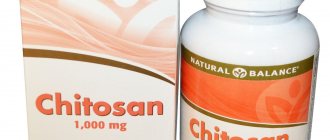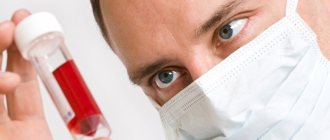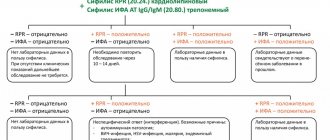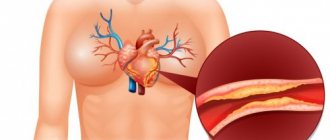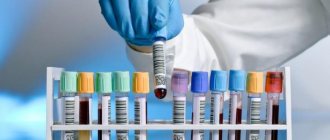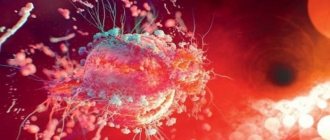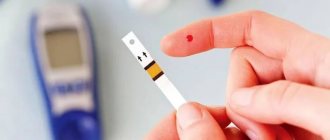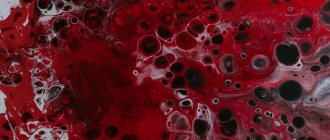An important indicator of a biochemical blood test is creatinine. This amino acid is formed in muscles after the non-enzymatic breakdown of creatine, a substance involved in the energy metabolism of the muscular system. The concentration of creatinine in the blood, with proper functioning of the muscular system and kidneys, is always maintained within certain values.
Deviations from the norm indicate a violation of the process of elimination from the body. The problem arises with kidney pathologies and impaired energy metabolism in the muscles. Understanding what creatinine is in the blood, the doctor can prescribe additional tests to make an accurate diagnosis in order to carry out the correct treatment.
How does the body produce creatinine?
The content of the article
Creatine is formed from creatine. Creatine is a nitrogen-containing carboxylic acid synthesized in muscles, kidneys, and pancreas. Sometimes it is additionally taken by athletes as an auxiliary nutritional supplement.
During fatigue, muscles convert creatine into energy, which powers muscle contractions. As a result, creatinine is obtained as the final product of metabolism. Creatinine is then released into the blood and excreted from the body through the urine of the kidney.
Although creatinine does not actively benefit or harm the body, the amount of creatinine in the blood can be measured to assess kidney health. For this reason, doctors often use a creatinine test to screen for chronic kidney disease (CKD) or kidney failure.
Hypercreatinemia as a sign of disease
An increase in creatinine is called hypercreatininemia. It can act as the main diagnostic criterion or an additional sign of many different diseases. Based on the degree of increase compared to the norm, one can roughly determine the causes of this condition. In this regard, it is advisable to highlight.
Slight and moderate hypercreatininemia (exceeding the norm by several tens of units)
- Any kidney pathology complicated by degrees 1 and 2 of organ failure;
- Liver damage of a toxic, inflammatory or cirrhotic nature;
- Massive tissue necrosis with gangrene of the limbs and internal organs;
- Traumatic damage to muscle tissue, bones and extensive skin burns;
- Hyperfunction of the thyroid gland (thyrotoxicosis);
- Diabetic nephropathy due to diabetes mellitus;
- Hyperfunction of the adrenal glands (hyprecorticism);
- Myasthenia;
- Toxic effects on the body caused by exposure to harmful substances or against the background of various serious diseases (infections, purulent-septic conditions, severe injuries, intestinal obstruction, peritonitis, etc.)
- Side effects of medications that have a nephrotoxic effect;
- Autoimmune pathology with massive damage to connective tissue (rheumatoid arthritis, lupus erythematosus, vasculitis);
- Dehydration of the body caused by insufficient fluid intake or excessive fluid loss;
- Decompensated heart failure with severe stagnation in the systemic circulation;
- Toxicosis complicating the course of pregnancy.
Severe hypercreatininemia (exceeding the norm by 100 mmol/l or more)
- Kidney diseases accompanied by stage 3-4 renal failure;
- Massive muscle destruction in muscular dystrophy;
- A common inflammatory process in the muscles (generalized myositis);
- Syndrome of positional or prolonged compression of large muscle masses. This group of causes also includes reperfusion syndrome, which forms after the resumption of blood circulation in the extremities, the vessels of which were blocked by blood clots;
- Leptospirosis and other severe infections.
Important to remember! Blood creatinine is one of the most important diagnostic criteria for assessing the functional abilities of the kidneys. Therefore, in practice, we most often encounter precisely this reason for its increase!
Why is a creatinine test prescribed?
Creatinine testing is used to evaluate the kidneys' ability to filter blood. Most often it is prescribed for:
- suspected development of renal failure;
- any kidney diseases - pyelonephritis, polycystic disease, urolithiasis, glomerulonephritis;
- severe injuries or burns;
- any injuries, atrophy or muscle tears;
- diseases of the endocrine system;
- diseases of the cardiovascular system;
- acute inflammatory diseases;
- sepsis;
- postoperative period.
Complexes with this research
Examination during pregnancy.
3 trimester 5,730 ₽ Composition For those at risk of COVID-19 Diagnosis of diseases complicating the course of coronavirus infection 2,590 ₽ Composition
Healthy interest Preventive examination to assess the general condition of the body RUB 2,440 Composition
IN OTHER COMPLEXES
- Check-up No. 1 for children and teenagers 6,560 RUR
- Biochemistry of blood. 8 indicators 990 ₽
- Pregnancy planning. Clinical indicators RUB 3,880
- Women's check-up No. 1 RUB 12,520
- Examination during pregnancy. 1st trimester 10,390 RUR
What is a good creatinine level?
In most cases, the normal range of creatinine found in the blood for people with healthy kidneys is:
| Age/gender | Normal blood creatinine value |
| Newborn babies | 20 - 75 µmol/l |
| Under 1 year | 15 – 37 µmol/l |
| 1 – 3 years | 21 - 36 µmol/l |
| 35 years | 26 - 41 µmol/l |
| 5 – 7 years | 27 - 51 µmol/l |
| 7 – 9 years | 34 - 52 µmol/l |
| 9 – 11 years | 33 - 66 µmol/l |
| 11 – 15 years | 45 - 75 µmol/l |
| Over 15 years old Men Women | 60 – 105 µmol/l 42 – 80 µmol/l |
Normal creatinine
All creatinine cannot be filtered and excreted by the kidneys. This is due to the fact that it is constantly released into the blood while the muscle tissue is viable. Blood plasma should contain a relatively stable concentration of creatinine, which may vary depending on age, muscle activity and nutrition. Therefore, there are maximum and minimum limits of normal creatinine, which take into account all these points and indicate the normal functioning of organs.
To eliminate errors in the results of a biochemical blood test based on creatinine levels, be sure to adhere to the general rules for blood sampling. The study must be carried out in the morning on an empty stomach. It is advisable to avoid strong muscle strain and overheating or hypothermia before directly drawing blood.
To illustrate the variations in creatinine standards, they are presented in table form:
| Age and gender | Small children | Pupils | Men | Women |
| Creatinine norm in µmol/l | 45-105 | 27-62 | 74-110 | 44-80 |
Creatinine norm in women
Plasma creatinine concentrations in women should be lower than in men. This is due to the physiological mechanisms of its formation, distribution and circulation in the blood.
The mechanisms of this phenomenon are as follows:
- A woman's muscle mass is less than that of a man;
- Less muscle strain;
- The activity of metabolic processes in the female body is reduced;
- Food products from the female diet contain less exogenous creatinine entering the body;
- The influence of sex hormones and pregnancy.
Creatinine norm in men
The creatinine of the male body should almost always be higher than that of women of the same age group. This is due to lifestyle characteristics and differences in the functioning of organs and systems. Age characteristics also affect the process of creatinine metabolism, both towards its increase and decrease. Recently, many men have been visiting gyms and using doping products containing creatine to increase muscle performance. This must be taken into account when assessing the creatinine norm.
Normal creatinine level in children
The concentration of creatinine in a child’s plasma largely depends on his age. The main fluctuations in this indicator are associated with growth activity and the degree of increase in muscle mass over a certain period of time. Newborns, due to the high stress that their body had to experience during childbirth, have creatinine levels the same as in adults. The same feature is typical for adolescents, which is explained by the active growth of the body. School-age children grow relatively steadily, so their creatinine levels are slightly lower than adults.
Creatinine is higher than normal - reasons
Physiological reasons:
- strength sports – powerlifting, bodybuilding, wrestling;
- large amount of muscle mass;
- predominance of meat dishes in the diet;
- the use of certain medications, for example, tetracycline antibiotics, non-steroidal anti-inflammatory drugs.
Pathological reasons:
- acute and chronic kidney diseases;
- diseases of the cardiovascular system;
- hyperthyroidism – excessive production of the hormone thyroxine by the thyroid gland; radiation sickness;
- oncological diseases;
- muscle injuries;
- septic shock;
- extensive burns;
- endocrine diseases.
References
- Clinical protocol for diagnosis and treatment of acute renal failure, 2014. - 24 p.
- Kucher, A.G., Kayukov, I.G., Yesayan, A.M. and others. The influence of the quantity and quality of protein in the diet on kidney activity. Nephrology, 2004. - Vol. 8(2). — P. 14‐34.
- KDIGO practice guidelines for the diagnosis, prevention and treatment of mineral and bone disorders in chronic kidney disease (CKD-MBD). Summary of recommendations. Nephrology, 2011. - T. 15(1). — P. 88‐95
- Nephrology. National leadership / ed. ON THE. Mukhina. - M.: GEOTAR-Media, 2009. - 720 p.
Increased red blood cell count?
Our body is a complex mechanism that reacts sensitively to any internal disruptions.
Every cell in it is important, not to mention the role of blood. Without blood, the body cannot function. Therefore, each component of the blood must work like a clock. Today we’ll talk about red blood cells - erythrocytes. They carry oxygen from the lungs to all organs and tissues and take waste carbon dioxide back to the lungs.
In addition to this transport function, red blood cells participate in water-salt metabolism and regulate blood acidity. Therefore, for optimal functioning of all organ systems, it is necessary that the level of these cells in the body is within normal limits.
When is the study ordered?
A biochemical blood test is recommended for the development of:
- sepsis (infection of the cerebrospinal fluid);
- renal failure;
- chronic high blood pressure (hypertension);
- state of shock.
In addition, before dialysis, it is necessary to undergo a procedure (blood purification for diagnosing kidney failure) and collect kidney samples.
Determination of creatinine levels is also necessary when a patient is admitted to the intensive care unit or intensive care unit.
How is diagnostics carried out?
To get the most reliable result, you need to properly prepare for the procedure. To do this, experts recommend following a few simple recommendations:
- avoid increased physical activity for a few days;
- the day before the session, refrain from eating large amounts of protein foods (a maximum of 200 grams of meat or fish is allowed);
- Avoid smoking and drinking alcohol;
- drink a lot of clean water.
If the patient is taking any medications, this should be reported to the attending physician. The specialist may recommend temporarily stopping the drug or take this factor into account when interpreting the data obtained.
Blood, serum, or urine can be used to test the enzyme concentration in the blood fluid. It is recommended to carry out the procedure in the morning on an empty stomach.
The sample is taken from a vein.
Urinalysis is a little more difficult to perform because it relies on measurements of the average daily value and clearance. The latter is based on the ability of the kidneys to clear creatinine from the blood.
In this case, urine collection is required throughout the day. The liquid is then sent in small quantities to a laboratory for testing.
It is also important that the urine container is clean and sterile. Collection begins after waking up, but the first urine is skipped.
A dark, cool place is used to store collected urine. It is important not to neglect the rules of hygiene. If dirt or foreign liquid gets into the container, you are more likely to get skewed results.
Only a specialist should interpret this information.
It is important to consider the patient's general condition, age and gender, physical activity and other factors that may affect creatinine levels.
What is creatinine?
Creatine
is an amino acid produced naturally in the body and obtained in small quantities from food. Creatine has gained popularity as a dietary supplement following evidence that it can increase body weight, improve physical endurance and speed recovery. When creatine is broken down, it is used for energy and creatinine remains as waste products. Creatinine levels vary depending on factors such as height, age, or gender, so there is no standard value.
3.How to measure creatinine clearance?
Glomerular filtration rate reflects the functioning of the kidneys. If the kidneys begin to function poorly, then creatinine clearance also decreases.
There are two main ways that doctors use creatinine to measure kidney function:
- Daily urine analysis, in which all the urine in one day is collected in a special container;
- Glomerular filtration rate can be measured using a one-time blood test, the results of which are inserted into a special formula for calculation.
Blood tests are used much more often because... it is more convenient.
Factors contributing to the decline
This condition, in which the indicator may be below normal, is recognized relatively rarely. This may depend on age or pregnancy. However, experts identify many common causes of low creatinine levels. These include:
- treatment with drugs from the group of corticosteroids;
- heart failure;
- following a vegetarian diet or following a strict diet;
- liver disease (cirrhosis);
- rapid loss of muscle mass;
- muscle injuries;
- pathologies of infectious origin, characterized by impaired renal blood flow;
- malignant tumors;
- severe dehydration of the human body;
- antidiuretic deficiency.
The reasons for the decrease in the content of this substance in the fair sex may be as follows:
- strict adherence to the diet;
- lack of meat in the diet;
- underweight;
- childbirth;
- use of glucocorticosteroids.
In men, creatinine falls as a result of:
- liver disease;
- severe renal impairment;
- cancer;
- heart failure;
- decreased muscle mass;
- shock;
- cirrhosis of the liver;
- following a protein-free diet.
In addition, age, sedentary lifestyle and use of muscle stimulants have a significant impact on enzyme concentrations.
To determine the exact cause of the deviation from the norm, it is necessary to conduct additional diagnostic studies.
Value Normalization Methods
The choice of therapeutic measures will depend on the factor that caused the decrease in enzyme concentration. In most cases, the main solution to the problem is to increase muscle mass.
Drug therapy
If the cause of the development of the pathology is any disease, then, based on diagnostic studies, the specialist will prescribe appropriate treatment with drugs. Only after the underlying disease is eliminated, the creatinine level will gradually return to normal.
Diet
In the absence of pathologies, first of all it is necessary to reconsider the diet. However, it should be borne in mind that the diet is not associated with the treatment of any serious disease (gout, pancreatitis, etc.).
It is recommended to include more high-protein foods in your daily menu.
Be sure to include in your diet foods such as:
- river and sea fish;
- meat products;
- nuts;
- seafood.
In some situations, when it is necessary to increase the enzyme level in a short time, the attending physician may advise taking special vitamin complexes, which in this case contain all the necessary microelements and substances.
ethnoscience
To normalize these indicators, patients often turn to folk remedies that help increase the level of creatinine in the blood fluid. It should be remembered that such treatment is possible only after consultation with a doctor.
Treatment
Low creatinine levels can indicate a variety of medical conditions, so your doctor will use the test results to determine underlying problems. If low creatinine levels, along with other symptoms, indicate liver disease, treatment most likely begins with medications and lifestyle changes. These changes may include eating healthier and avoiding alcohol.
If a person has a muscle disorder, treatment may include exercise therapy, medications, or surgery.



